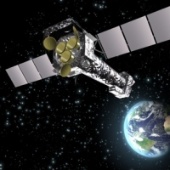ESA Science & Technology - News Archive
News archive
News archive
The discovery of two massive galaxy clusters, made possible thanks to a new, novel observing mode on XMM-Newton, opens a new window to study the Universe's largest bound structures ....
Published: 31 May 2010
Observations with XMM-Newton and Chandra have provided a robust detection of a vast
reservoir of intergalactic gas about 400 million light years from Earth.
Published: 11 May 2010
The latest edition of the 2XMM catalogue boasts an additional 42 000 entries , bringing the total to over a quarter of a million X-ray sources. This unprecedented cosmic X-ray library is a valuable resource allowing astronomers to explore the extreme Universe.
Published: 28 April 2010
Observations of faint and distant galaxy groups made with the European Space Agency's XMM-Newton observatory have been used to probe the evolution of dark matter.
Published: 20 January 2010
On 10 December 1999 Ariane 504 blasted off from Kourou in French Guiana carrying onboard ESA's flagship X-ray observatory, XMM-Newton. In the intervening decade this astronomical workhorse has played a significant role in revolutionizing X-astronomy.
Published: 10 December 2009
XMM-Newton observations of the X-ray pulsator RX J0648.0-4418 have resulted in a solid, model-independent mass estimation of this rare, ultra-massive white dwarf.
Published: 4 September 2009
Published: 27 August 2009
Detailed observations of the first new Soft Gamma Repeater in 10 years strengthen the unified view of the magnetar phenomenon; INTEGRAL and XMM-Newton target of opportunity programmes played a crucial role in this result
Published: 16 June 2009
The simultaneous detection of broad K and L iron lines in an AGN reveals hitherto unobserved details of the geometry and dynamics of the supermassive black hole at the centre of this galaxy.
Published: 27 May 2009
The XMM-Newton mission passes another milestone this month with the publication of its 2000th scientific paper in peer-reviewed scientific journals.
Published: 17 February 2009
A recent model of the emission from ultra-magnetized neutron stars (magnetars) shows great promise in offering a unified view of the high energy emission from these objects.
Published: 14 November 2008
XMM-Newton, ESA's X-ray observatory, has reestablished communication contact with Earth, showing that the spacecraft is safe and fully under control. The news was confirmed this morning by the mission control team at ESA's European Space Operations Centre (ESOC) in Darmstadt, Germany.
Published: 23 October 2008
During last weekend ESA lost contact with its XMM-Newton X-ray observatory. Many space agencies and organisations are now joining forces trying to fix the problem: a feeble radio signal has been heard, and ground-based observations confirm that the spacecraft is intact.
Published: 22 October 2008
The first detection of strong, quasi-periodic oscillations (QPO) in the X-ray emission of an active galaxy (RE J1034+396), obtained with XMM-Newton, is reported in the 18 September issue of Nature
Published: 17 September 2008
Published: 26 August 2008
XMM-Newton has discovered a rare, very massive cluster of galaxies at a redshift z~1. The object, designated 2XMM J083026+524133, is the most X-ray luminous known at its distance and beyond
Published: 25 August 2008
A nova explosion is usually detected first at optical wavelengths. The recent nova V598 Puppis, although being among the brightest novae, was instead discovered first in X-rays by XMM-Newton, some four months after the optical emission had peaked
Published: 18 July 2008
Published: 23 June 2008
Analysis of XMM-Newton data of G350.1-0.3, a bright galactic radio source, reveals it to be a young and bright supernova remnant (SNR). These results are published in the 10 June issue of ApJ Letters
Published: 9 June 2008
The May 2008 issue of the ESA Bulletin features an article on "The next decade with XMM-Newton - Its scientific impact and challenges for the next 10 years".
Published: 6 June 2008
—
20 Items per Page



















